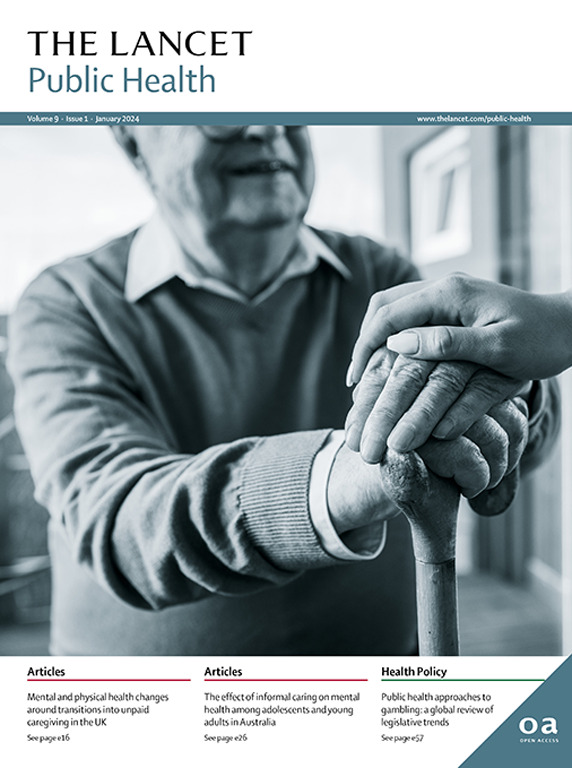结核分枝杆菌感染风险的性别差异:基于人群的免疫反应性调查的系统回顾和荟萃分析
IF 25.2
1区 医学
Q1 PUBLIC, ENVIRONMENTAL & OCCUPATIONAL HEALTH
引用次数: 0
摘要
2023年,全球有125万人死于结核病。男性的结核病发病率是女性的1.7倍,但尚不清楚这种差异在多大程度上是由于更多地暴露于结核分枝杆菌所致。我们旨在分析年龄和性别对结核分枝杆菌免疫反应性的影响。在这项系统评价和荟萃分析中,我们回顾了Embase、Global Health数据库、Science Citation Index Expanded和Global Index Medicus在1993年1月1日至2022年12月31日期间在结核病高发地区进行的基于人群的结核分枝杆菌免疫反应性(使用干扰素γ释放试验或皮肤试验)调查,样本量至少为150人。我们纳入了横断面调查、干预性或队列研究的基线调查,以及具有人口代表性群体的病例对照研究的对照组。我们提取了结核分枝杆菌免疫反应性流行率的数据,按性别和年龄组分列。我们构建了贝叶斯层次模型,首先是免疫反应性的年龄和性别患病率,其次是男性对女性(M:F)患病率的年龄比。我们分析了包括地区、结核病发病率和研究年份在内的协变量的影响。本研究已在PROSPERO注册(CRD42022360483)。结果:我们筛选了26517项研究,其中167项符合纳入标准。按性别分类的结果来自38个不同国家的80项研究(81项调查),包括来自478968名参与者的数据。我们发现儿童时期结核分枝杆菌免疫反应性的性别差异不大(10岁以下儿童结核分枝杆菌患病率为0.95;95%可信区间0·90-1·01)。然而,从青春期开始,男性的免疫反应性转换比女性高(到30岁时高1.4倍)。这种较高的转化率累积推动了男性较高的免疫反应性患病率,10-19岁人群的患病率为1.07(95%可信区间为1.01 - 1.13),20 - 39岁人群的患病率为1.13(95%可信区间为1.06 - 1.20),40岁及以上人群的患病率为1.28(95%可信区间为1.19 - 1.37)。在不同的环境中,成年男性的结核分枝杆菌患病率始终较高,研究间结核分枝杆菌患病率的异质性较低。男性结核分枝杆菌免疫反应性风险高于女性,这可能是全球结核病发病率和死亡率性别差异的关键驱动因素。这种差异可能是由于在发生结核病传播的聚集室内空间中所花费的时间的社会和行为差异造成的接触率较高,而男性感染持续时间较长以及年龄和性别混合进一步放大了这种差异。针对男性结核分枝杆菌暴露的决定因素的公共卫生干预措施对于结束结核病流行至关重要。资助惠康信托和英国外交,联邦&;发展办公室。本文章由计算机程序翻译,如有差异,请以英文原文为准。
Sex differences in the risk of Mycobacterium tuberculosis infection: a systematic review and meta-analysis of population-based immunoreactivity surveys
Background
Tuberculosis killed 1·25 million people globally in 2023. Men have a 1·7 times higher tuberculosis incidence than women, but it is not known to what extent this discrepancy is driven by greater exposure to Mycobacterium tuberculosis. We aimed to analyse the effect of age and sex on M tuberculosis immunoreactivity.Methods
In this systematic review and meta-analysis, we reviewed Embase, Global Health databases, Science Citation Index Expanded, and Global Index Medicus for population-based M tuberculosis immunoreactivity (with interferon-γ release assay or skin test) surveys done in high tuberculosis incidence settings from Jan 1, 1993, to Dec 31, 2022, with a sample size of at least 150 people. We included cross-sectional surveys, baseline surveys for interventional or cohort studies, and control groups of case–control studies with population-representative groups. We extracted data on M tuberculosis immunoreactivity prevalence, disaggregated by sex and age group. We constructed Bayesian hierarchical models, first of immunoreactivity prevalence by age and sex and second of the male-to-female (M:F) prevalence ratio by age. We analysed the effect of covariables including region, tuberculosis incidence, and study year. This study was registered on PROSPERO (CRD42022360483).Findings
We screened 26 517 studies, of which 167 met our inclusion criteria. Sex-disaggregated results were available from 80 studies (81 surveys), from 38 different countries, comprising data from 478 968 participants. We found little sex difference in M tuberculosis immunoreactivity in childhood (M:F prevalence ratio for children younger than 10 years was 0·95; 95% credible interval 0·90–1·01). However, from adolescence onwards, men experienced higher immunoreactivity conversion than women (1·4 times higher by age 30 years). This higher conversion rate cumulatively drove a higher immunoreactivity prevalence in men, with a prevalence ratio of 1·07 (95% credible interval 1·01–1·13) in those aged 10–19 years, 1·13 (1·06–1·20) in those aged 20–39 years, and 1·28 (1·19–1·37) for those aged 40 years and older. Adult men had consistently higher M tuberculosis prevalence across different settings, with low between-study heterogeneity in M:F prevalence ratio.Interpretation
Men have higher M tuberculosis immunoreactivity risk than women, which is likely to be a key driver of the sex differences in global tuberculosis morbidity and mortality. This difference could be due to higher exposure through social and behavioural differences in time spent in congregate indoor spaces where tuberculosis transmission occurs, further amplified by longer duration of infectiousness in men, and age-assortative and sex-assortative mixing. Public health interventions addressing men's determinants of M tuberculosis exposure will be crucial to ending the tuberculosis epidemic.Funding
Wellcome Trust and UK Foreign, Commonwealth & Development Office.求助全文
通过发布文献求助,成功后即可免费获取论文全文。
去求助
来源期刊

Lancet Public Health
Medicine-Public Health, Environmental and Occupational Health
CiteScore
55.60
自引率
0.80%
发文量
305
审稿时长
8 weeks
期刊介绍:
The Lancet Public Health is committed to tackling the most pressing issues across all aspects of public health. We have a strong commitment to using science to improve health equity and social justice. In line with the values and vision of The Lancet, we take a broad and inclusive approach to public health and are interested in interdisciplinary research.
We publish a range of content types that can advance public health policies and outcomes. These include Articles, Review, Comment, and Correspondence. Learn more about the types of papers we publish.
 求助内容:
求助内容: 应助结果提醒方式:
应助结果提醒方式:


